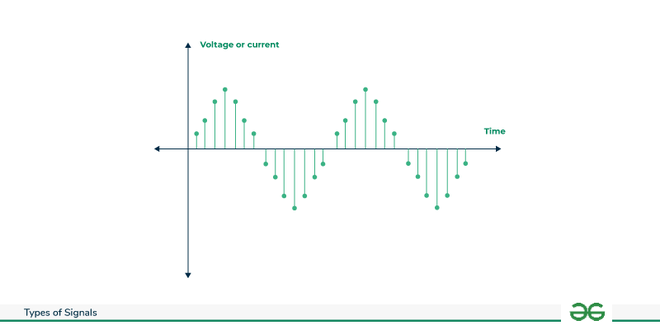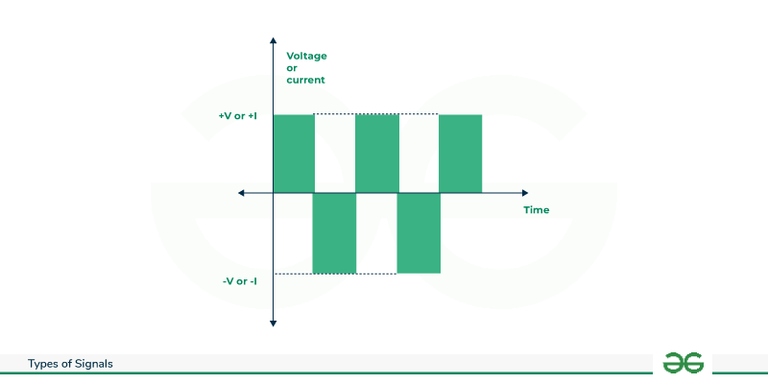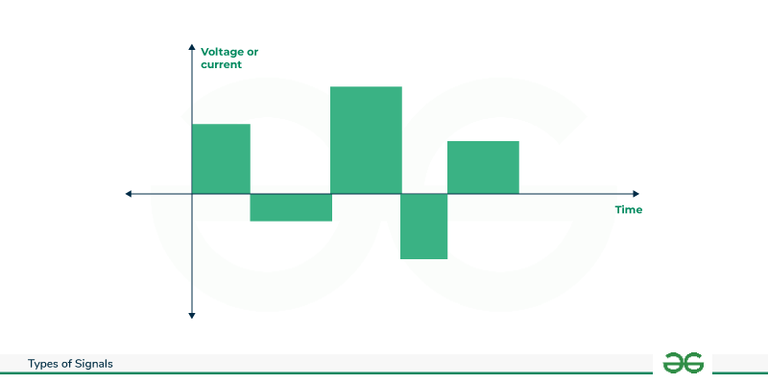An electrical signal is a physical quantity that varies with time. It varies with any dependent or independent quantity. A signal can either be one-dimensional or multi-dimensional. When the function which varies with time depends only on a single variable then that type of signal is referred to as a one-dimensional signal. Examples of such signals are audio signals, biometrics like pulse or heartbeat, light wave signals, etc. On the other hand, a signal that is dependent on more than one time-dependent variable, then that type of signal is known as a multi-dimensional signal. Examples of two-dimensional signals are electromagnetic signals, video signals, etc. A signal is a mathematical representation of energy.
Thus, signal is a time-dependent function that can be dependent on one or more than one physical quantity for the transference of data and information with or without the presence of the medium. Electromagnetic wave signals can travel in a vacuum whereas sound and electrical signals require a medium for their propagation.
What are Signals ?
Signals in electrical circuits are defined as the change of voltage or current with time. In other words, electrical signals are electromagnetic or electrical waves that carry information in an electric network or circuit.
Transfer of data and information is done via signals, such as audio and video signals which helps in communication through any medium such as optical, electromagnetic, wireless, or wired medium. Signals are processed through various devices like ICs (Integrated circuits), transistors, and diodes.
Characteristics of Signals
Some of the basic characteristics of the signal are discussed below:
- Amplitude: Amplitude is one of the main characteristics of any signal. It is defined as the maximum displacement of wave (current or voltage) from the time axis. It determines the strength of a signal.
- Frequency: The frequency of any signal is defined as the number of oscillations that could be performed by wave particles of any signal wave in one second. It determines the speed of the wave in any medium.
- Time period: The time period of a signal is defined as the time taken by a signal to complete one full cycle.
Operations on Signals
Basic operations which can be performed on any signal are given below:
- Amplification: Amplification in electric signal is a process in which amplitude or strength of a signal is increased. A device named amplifier is used to perform the operation of amplification. This operation is mainly used for effective transmission of a signal because intensity of a signal decreases during transmission, so to regain that amplitude the process of amplification is required.
- Attenuation: Attenuation in an electric signal is a process in which there is decrease in amplitude or strength of a signal. During transmission, a signal may be subjected to various disturbances like noise, echo or dispersion which results in decrease in amplitude and thus, attenuation takes place.
- Modulation: Modulation is an operational technique which is performed on a signal in which various characteristics of a signal is changed so that it could be transmitted to a longer distance without any loss of information which is to be carried by a signal.
- Encoding: Encoding refers to a technique in which a special code is applied on any signal’s information, and it gets converted to a particular format so as to shield it from noise and distortion and to provide privacy and security during transmission of a signal.
- Decoding: Decoding of an electrical signal is a process in which encoded signal is converted back into its original form. It’s purpose is to provide receiver the original data which was transmitted by the sender.
Classification of Signals
Signals classified on the basis of various categories. Some of the basis categories and its classification is discussed below:
On the Basis of Type
Signals can be classified on the basis of its type into following two groups:
- Analog Signal
- Digital Signal
Analog Signal
In analog signal, the physical quantities such as current or voltage varies continuously with time. These signals get stored in the form of wave signal. It also has low impedance. Example- Sinusoidal wave, triangular wave, etc.

Analog-Signal
Digital Signal
In digital signal, the physical quantities such as current or voltage can have only one of the two possible values at a time, i.e., digital signal have only levels, either zero or some maximum finite value of current or voltage. These signals get stored in the form of binary bit. It is having high impedance which may reach to 100 megaohms.

Digital-Signal
On the Basis of Time
Signals can be classified on the basis of its nature into following two groups:
- Continuous Time Signal
- Discrete Time Signal
Continuous Time Signal
In continuous-time signal at each point of time, signal will have some continuous values. These of signals can be analyzed using techniques such as Fourier or Laplace transformations. It requires more space than discrete-time signal because it has to be firstly sampled before transmission. This signal has infinite bandwidth and can be represented using signals like sine or cosine waves.

Continuous Time-Signal
Discrete Time Signal
In discrete-time signal at each point of time, signal will have distinct or discontinuous values. These types of signals can be analyzed using techniques like discrete Fourier transformations or z-transformations. It requires less space than continuous-time signal as they are represented by some specific set of numbers. Discrete-time signal has finite bandwidth.

Discrete Time Signal
On the Basis of Nature
Signals can be classified on the basis of its nature into following two groups:
- Periodic Signal
- Aperiodic Signal
Periodic Signal
A periodic signal have constant frequency and have a characteristic signal which repeats itself at regular intervals, i.e., it has a repeating waveform. At some specific frequencies this type of signal has high concentration of energy. These signals are commonly used in communication centers. Some of the common examples of periodic signals are square wave, triangular wave, sine wave, etc.

Periodic-Signal
Aperiodic Signal
A aperiodic signal also referred as non-periodic signal does not repeat itself at regular intervals, i.e., it does not have repeating waveform. non- periodic signal’s energy is distributed over whole range of frequencies. Non-periodic signals are commonly used in study of chaotic systems. Some of the common examples of aperiodic signals are noise, speech, etc.

Aperiodic-Signal
On the basis of Behaviour
Electric signals can be classified on the basis of its behaviour into following two groups:
- Deterministic signal
- Random Signal
Deterministic signal
Deterministic signal is the type of signal that follows a fixed and regular pattern means it can be determined and accurately produced. This type of signal has well-defined wavelength, frequency and phase.

Deterministic-Signal
Random Signal
Random signal is a type of signal that has irregularity means it cannot be determined and cannot be accurately produced. This type of signal lacks regularity and has out of phase wavelength, frequency and pulse width.

Random-Signal
On the basis of Symmetry
Signals can be classified on the basis of its symmetry into following two groups:
Even Signal
The signal which is symmetrical about its vertical axis is called as even signal. Hence, it is also called as symmetrical signal. Even signal has same value of current or voltage for both positive and negative time interval.
Mathematically, it is represented as:
f(t) = f(-t)
Example of even signal is cosine signal.

Even-Signal
Odd Signal
The signal which lacks symmetry about its vertical axis but has rotational symmetry (Anti symmetrical about origin) is called as odd signal. Hence, it is also called as asymmetrical signal. Odd signal has negative value of current or voltage when positive time interval(t) is replaced by negative time interval(-t).
Mathematically, it is represented as:
f(t) = -f(-t)
Example of odd signal is sinusoidal signal.

Odd-Signal
Applications of Signals
Some of the applications of signal are listed below:
- These are mainly used in telecommunication industry for transmitting data and information through signals.
- Signals are used in satellite communication and radar systems to detect or communicate to various objects like planes and satellites.
- Signals also finds their application in medical field for various purposes like ECG tests, ultrasound and CT scan.
- Signals are also used in weather forecasting and also in other monitoring techniques like checking pollution levels, estimating temperature and humidity of the day, etc.
- Media channels broadcasting through televisions and radios takes place by via signals.
Advantages of Signals
Some of the main advantages of signal are given below:
- Signals are used in transfer of information as they travel with speed of light, and thus facilitates faster communication.
- Signals are easily convertible to analog to digital form which facilitates working on many devices via signal.
- Signals are used in calibrating various instruments which helps in producing accurate and precise results.
Disadvantages of Signals
Some of the demerits of signal are listed below:
- Data and information that are transmitted through signal are subjected to security risks, thus resulting in misuse of sensitive information.
- Signal which is to be delivered to receiver may be attenuated, which results in loss of information which was present in signal.
- Signals are prone to error during propagation by another signal or by any external factor, thus it results in degradation of quality and reliability of information.
Conclusion
Therefore, signal plays a major role in advancement of science and technology due to propagation and transmission of data and information at high speed. A deep knowledge of characteristics and operations of signals helps in advancement and development of various industries like telecommunications, media industry and many more. Due to its property of long distance travel, signals find its application in transference of data and in control centres. It also helps in communication by exchange of information and transmission of data among people from different parts of the world which would help in all round development .
Although, transfer of information via signal offers many advantages but it is also exposed to degradation and distortion of transmitted signal. Thus, proper modulation techniques should be performed in order to maintain reliability of transferred data. Because of modulated data due to distortion of signal, devices which operate on input signal will lead to malfunctioning of device and producing inaccurate output which would lead to wrong actions due to faulty received signal. Modulated data can also cause financial loss as seen in case of financial markets like share market or stock market.
Thus, propagation of data or information through signal requires proper techniques in order to secure an uninterrupted communication. The development of signals would help in development and upgradation of latest electronic equipments and communication systems.
FAQs on Types of Signals
Q1. What is signal?
Signal is a fundamental quantity which transfer information in the form of waves through a transmissible medium.
Q2. What is the difference between amplitude and magnitude of a signal?
Amplitude of a signal is a vector quantity which tells the maximum displacement of signal’s wave. It depicts both strength and direction of a signal. Magnitude of a signal is a scalar quantity which only depicts the strength of a signal.
Q3. What is the impact of noise on quality of a signal?
Noise during signal transmission causes distortion of waves of signal which degrades the quality and reliability of information which is to be transferred through the signal.
Share your thoughts in the comments
Please Login to comment...